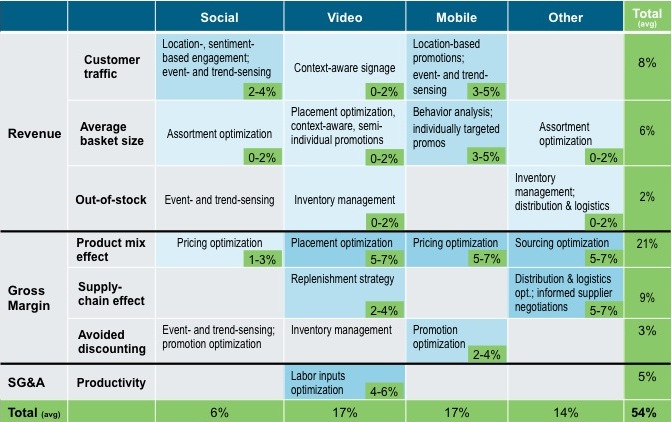Retailers looking at the Big Data opportunity may well find themselves with an array of choices: the opportunities seem so vast, where does one begin?
Well, a pragmatic way forward is to focus on some pragmatic possibilities and then “follow the money”!
In examining the Big Data opportunity for retailers, Cisco IBSG has identified three key areas where we believe value can be generated through Big Data analytics – and we have put together a framework for assessing and comparing the financial impact of options within these areas.
As outlined in our previous report, “Surfing the Data Deluge: How Retailers Can Turn Big Data into Big Profits,” three areas – video, social and mobile data –promise unprecedented insights into what consumers want or need, at the earliest stages of interest, and will drive the Big Data thrust in retail over the next few years. These three essentials not only represent a major stream of incoming data, but also provide an outbound mechanism to communicate with customers on a more personalized basis. In other words, they are both a source of Big Data analytics and a way of implementing Big Data insights!
- High-definition cameras, combined with Big Data analysis, promise a wealth of new insight, from facial recognition and information on shopping partners to demographic information (and digital signs can help the store adapt to Big Data insights in real time).
- Social media will offer retailers relevant and detailed “pictures” of their customers, including demographics, influences, interests, buying history, and preferences.
- Mobile devices can provide location data and access to a wide range of personal history, purchase records, and preferences, as well as being a great platform for customer interactions.
We see each of these focus areas as offering the possibility to drive value in several parts of the business. To evaluate the different options, we consider the impact of each technology upon revenue, margin, and operating costs:
- Revenue: increased customer traffic, larger basket sizes, fewer out-of-stocks
- Margin: more profitable product mix, more efficient supply chain, avoided discounting
- SG&A: more efficient store operations
By applying this framework to video, social, and mobile technologies, we identified some 20 Big Data applications and quantified the likely opportunity associated with each for an illustrative retailer. We estimate potential after-tax operating profit gains of 17 percent, 6 percent, and 17 percent from video, social, and mobile, respectively, combined with 14 percent profit from additional sources—adding up to an impressive 54 percent after-tax gain.

Source: Cisco IBSG, 2012
While operational limitations will mean that not all of these gains are realized, and competitive dynamics will ensure that some of these become “health factors” reflecting “loss avoided” rather than “value gained,” the framework provides a consistent and quantified approach across all options, allowing for an open discussion of assumptions and expectations, and a prioritization of projects for immediate consideration. Cisco IBSG is now working with retailers across the globe to flesh out business cases at the next level of detail — work that can be undertaken only after the overall pockets of Big Data value have been unearthed in this way.
For retailers looking to explore Big Data opportunities, the message is clear: Focus around social, video, and mobile opportunities; identify concrete project possibilities within these areas; and then follow the money to identify two or three high-impact initiatives for initial implementation. For more insights on Big Data, please read our report: Surfing the Data Deluge: How Retailers Can Turn Big Data into Big Profits.

Thank you Richard! This is very insightful!